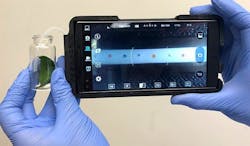Researchers ask industry to develop sensors to detect airborne pathogens like COVID-19 in seconds or minutes
ARLINGTON, Va. – U.S. military researchers are asking industry to develop technologies for sensors able to detect low concentrations if airborne viruses in room-size spaces within seconds to minutes to help detect the presence of pathogens like the COVID-19 coronavirus and prevent its spread.
Officials of the U.S. Defense Advanced Research Projects Agency (DARPA) in Arlington, Va., issued a solicitation on Monday (DARPA-PA-20-01-04) for the SenSARS program.
The COVID-19 coronavirus pandemic has highlighted the need for improved environmental sensing of pathogens. Sensing SARS-CoV-2 virus in the air with high sensitivity could provide a new mechanism for public health monitoring to enable safe conditions for work, travel, and school.
The SenSARS project aims to identify SARS-CoV-2 signatures suitable for rapid indoor air monitoring and, use these signatures to develop and demonstrate a technology readiness level (TRL) 4 prototype sensor.
Recent developments in radio frequency vibrometry, improvements in terahertz sources and sensors, improvements in mass spectrometric techniques, emerging immunosensing techniques, electrochemical detection methods, and advances in signal analysis using machine learning approaches potentially could help monitor for SARS-CoV-2 airborne pathogens.
These approaches have the potential to enable sample agnostic detection of low viral concentrations within seconds to minutes for real-time aerosol detection. Improvements in portability of traditional methods of detection – immunoassays and nucleic acid-based assays – out of the lab setting may enable onsite confirmation of results.
Most SARS-CoV-2 detection systems require collecting a sample and sending it to a lab, which can take hours or days, which is too slow for atmospheric sampling.
Related: Trenton Systems remains focused on COVID-19 prevention in the workplace
On the other hand, current air-breathing environmental sensors using optical techniques offer fast detection times but limited ability to discriminate between benign and pathogenic material, such as the SARS-CoV-2 virus.
In general, current methods are not suitable for room-sized, indoor environmental monitoring and lack practical combinations of sensitivity, precision, acceptable false positive rates, and speed. Today's methods also scale poorly because of costs and size, weight, and power requirements.
The SenSARS program will have two phases. The nine-month phase one focuses on determining environmental SARS-CoV-2 signature feasibility, and the he nine-month phase two option seeks to refine signatures and produce and demonstrate a TRL 4 prototype sensor. Selection for the Phase 2 option depends on Phase 1 results and funding availability.
DARPA researchers are interested in technologies that are extensible to other pathogens beyond SARS-CoV-2; adaptable enough to detect new pathogens within 1 week to a month after discovery; and can save samples for additional analysis.
Companies interested should upload proposals no later than 1 Dec. 2020 to the DARPA BAA website at https://baa.darpa.mil.
Email questions or concerns to [email protected]. More information is online at https://beta.sam.gov/opp/a84f1af107334afcbf39d885d8f668a3/view.
